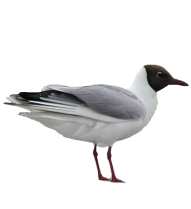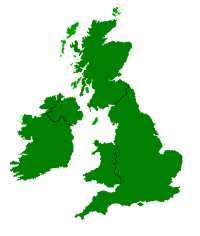|
|
Black-headed Gull Plate | ||||
|
|
|||||
| Distinguishing Features |  |
||||
| Height 36cm (14in), Chocolate brown head during summer months, fading to white with brown spot behind the eye during the winter. Grey wings with black wing tips and red legs. | |||||
| Food | |||||
| Insects, worms, small fish and crabs. Swarming ants, scavenging around towns, rubbish tips. | |||||
| (Laridae) larus ridibundus |
|||||
|
|
|||||
 |
Nesting | ||||
| Between April and July. Clutch of 2 to 3 eggs, buff to brown or blue green. Incubation appx 23 days. One brood tended by both parents. | |||||
| Habitat | |||||
|
Black-headed Gulls can be found inland as well as on the coast. Sand dunes, marshes, gravel pits, lakes and reservoirs |
|||||
|
The darker green on the map above indicates
where you are most likely to see a Black-headed Gull..
|
|||||
|
|
|||||
| Other information | |||||
|
The Black-headed Gull is one of the most common gulls found in GB and Eire. Although the Black_headed Gull is primarily a sea bird, it can be found far inland. Like most gulls the plumage from birth goes through a number of stages before reaching its mature adult stage. This takes two years. The Black-headed Gull looks quite different during the winter, when it looses its dark brown plumage on its head. The head turns white with a small dark spot behind the eye. Black-headed gulls build their nests on the ground in colonies and usually consist of a pile of vegetation which is constructed by both parents. |
|||||
| [Home] [News] [Gallery] [Birds] [Discover] [About] [Contact] [Members] | |||||